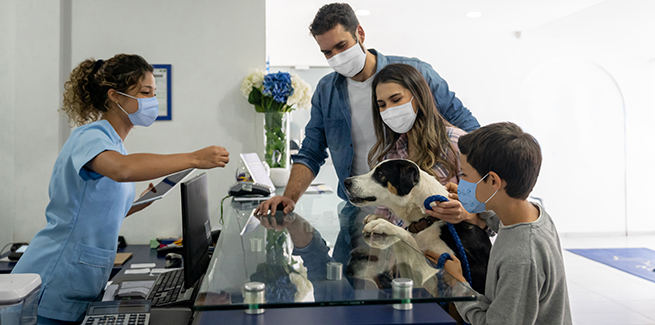Safety protocols to consider before reopening your hospital

Some veterinary hospitals are quietly reopening to let clients back into the building, while others are biding their time. But with most states scheduled to be fully open with a few restrictions by July 4, many veterinary professionals are getting restless.
No one seems quite sure what to do next, as there’s no generally agreed-upon guidance as to the best ways to reopen hospitals safely, or when.
Pam Nichols, DVM, CCRP, president on the AAHA Board of Directors and owner of AAHA-accredited Animal Care Daybreak in South Jordan, Utah, told NEWStat that her hospital has “cautiously” reopened to the public: “We ask that clients still text upon arrival and we invite them in [once] the prior clients have left. We ask them if they’re comfortable masked or unmasked and we follow suit.”
Besides that, as far as protocols, “It was [by the] seat of our pants,” she said.
The AVMA’s endorsement of the CDC’s interim advice for safe clinic protocols gave some direction, and the AVMA noted that the CDC is working to update those protocols, but until they do, it can sometimes feel like a case of “hurry up and wait.”
Meanwhile, J. Scott Weese, DVM, DVSc, DACVIM, has published an update of his own.
An associate professor in the Department of Pathobiology at the University of Guelph in Ontario, Canada, and a contributing reviewer of the 2018 AAHA Infection Control, Prevention, and Biosecurity Guidelines, Weese authored a series of in-depth guides on COVID-19 safety protocols for hospitals on behalf of the Ontario Veterinary Medical Association (OVMA) that were widely used in the US, especially during the early days of COVID, when many hospitals were unsure of what steps to take.
He published the latest revision on June 15.
Weese told NEWStat that most veterinary hospitals in Canada are still closed to clients, although there are exceptions here and there. But, unlike some US hospitals, most Canadian hospital staff are still donning masks—a practice that, according to Weese, has not been met with a great deal of opposition.
He noted that the US is in a bit of a tenuous situation in some areas due to a combination of plummeting vaccination rates, ongoing transmission among unvaccinated people, and the emergence of new COVID strains (such as the delta variant). “There’s a good chance some places are going to have issues this summer and fall,” he said.
Weese said his updated guidelines focus on precautions such as:
- Limiting the number of people in the hospital
- Maximizing spacing
- Limiting contact times
- Optimizing ventilation
Other possible safety considerations include the use of plexiglass barriers, which Weese says “can be good or bad, depending on the circumstances.”
As for when veterinary hospitals can consider it safe to fully reopen and bring clients back inside, Weese said it really varies. “There’s no one-size-fits-all approach. [Many] factors are involved in deciding when and how to relax measures such as allowing clients into clinics.” But practice-specific considerations he advises people to consider include:
- Vaccine coverage (full vaccination) in the area
- Vaccine coverage in the practice
- Variants of concern dynamics in the area
- Ability to optimize infection-control practices and ventilation
- Risk aversion
- Risk status of people in the practice
- Ability to use hybrid measures (e.g., curbside and telemedicine) to reduce overall in-hospital numbers
Check with your county and state health departments for information on vaccine coverage, rates of transmission, and variants of concern in your area.
Photo credit: © andresr/E+ via Getty Images



